Blancpain Tribute To Fifty Fathoms MIL-SPEC: Ready For More Than A Quick Swim
The history of underwater diving goes back much further than many might think. People have likely been swimming and diving for tens of thousands of years and it became a practiced and technological endeavor very early on.
As far back as ancient Greece, divers began using stone ballast for fast descent dives, a technique called Skandalopetra diving. Diving bells were also reportedly used as far back as the fourth century BCE, with stories of Alexander the Great even exploring the floor of the Mediterranean.
However, it still would take many centuries for more advanced technological equipment to be developed including diving suits and helmets. The first documented diving suit was made in 1602 in Spain, and the first surface-supplied-air diving helmet was developed in the early nineteenth century in England.

This illustration of the Deane diving helmet appeared in a an issue of ‘Magazine of Science’ in 1842
Advancements in manufacturing technologies helped drive development as old ideas could finally be made well enough to work or be proven as dead ends. Atmospheric diving suits (fully enclosed air pressure suits to allow deeper dives) were first developed in 1715, though not very practical until the twentieth century.
The development of atmospheric diving suits went hand in hand with the development of SCUBA (Self-Contained Underwater Breathing Apparatus), which in itself began with the above-mentioned first documented machine diving suit in 1715. But it would take another 210 years before high pressure containers could be made strong and reliable enough to be used for safe self-contained underwater breathing.
In 1926, the first successful open-circuit scuba system was tested in France by Yves Le Prieur using a tank pressurized to 2,100 psi with a simple pressure regulator and constant air supply. Its use was limited, but it proved the concept had fins (see what I did there?).
Of course, as most diving fans will know, in 1942 during the German occupation of France, Jacques-Yves Cousteau and Émile Gagnan developed the first truly successful and useful open-circuit scuba system, which would go on to be called the Aqua-Lung.
From then on, the development of underwater diving technology raced forward as industrialized manufacturing expanded materials and equipment capabilities for use underwater. As soon as the specific diving equipment needed for breathing and moving about reached maturity, focus could shift onto accessories and peripheral equipment, i.e., diving aids.
One of the most important diving aids, it was soon discovered, was a reliable timepiece for keeping track of elapsed time underwater, and more importantly, to time decompression stops during ascent, which are critical to preventing decompression sickness.
So as the history of diving technology continued to unfold, the history of diving watches began. As any hard-core diving watch fanatic will tell you, this is where the Blancpain Fifty Fathoms steps into the spotlight.
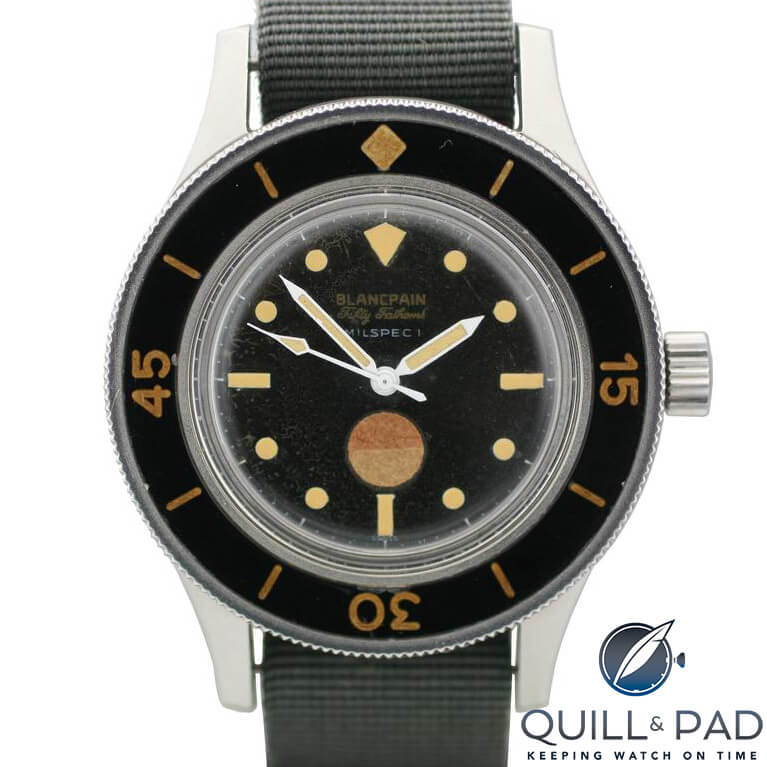
Original 1957-1958 Blancpain MIL-SPEC 1
Enter stage right
Considered by many to be the first true dive watch as we know the genre today, the Fifty Fathoms first launched in 1953 became a hit around the world with militaries and professional divers alike.
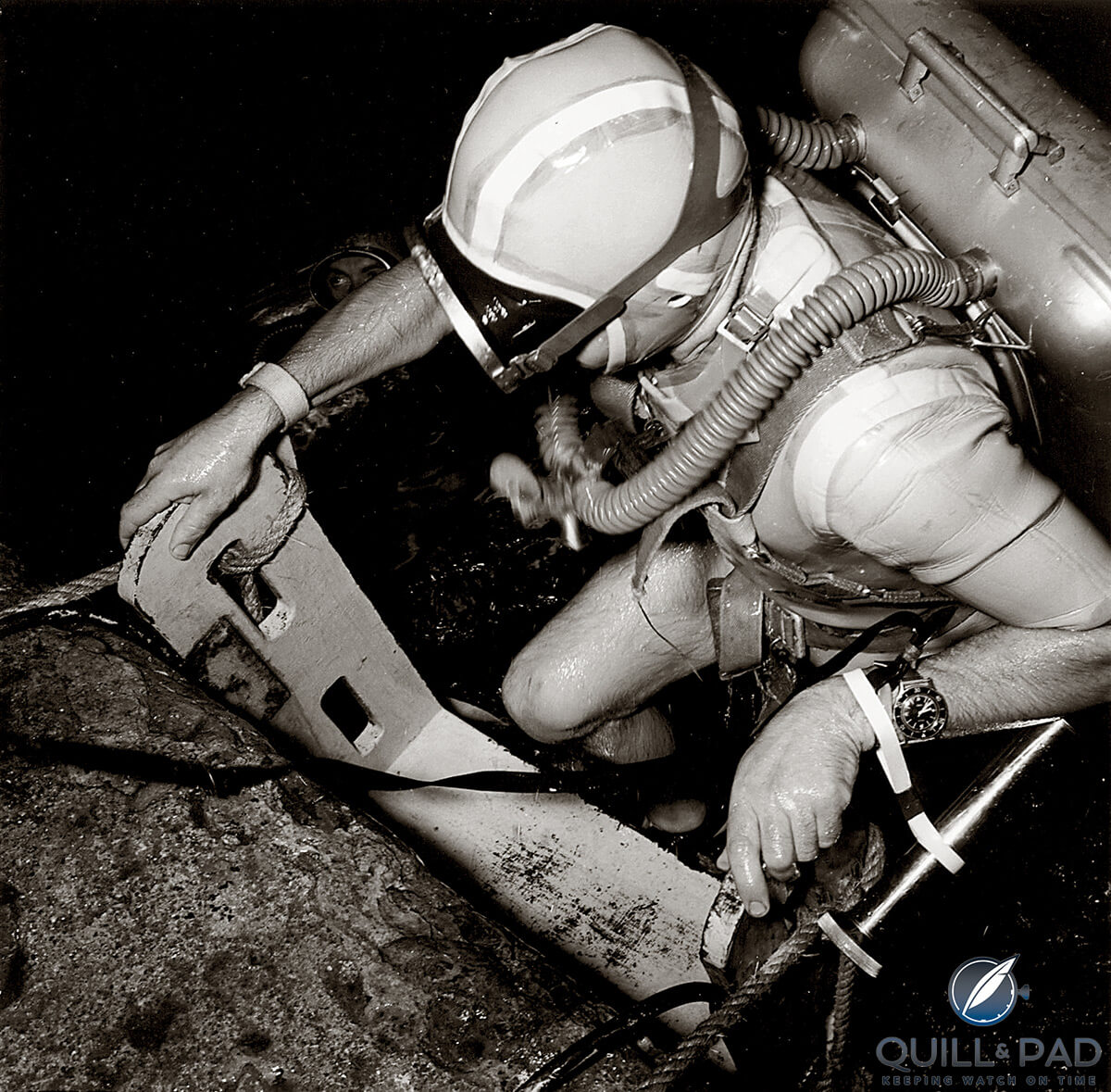
Historic photo of Bob Maloubier diving while wearing (and trusting) a Blancpain Fifty Fathoms on his wrist

Then-American president John F. Kennedy speaking with U.S. Navy Seal divers wearing Blancpain Fifty Fathoms dive watches
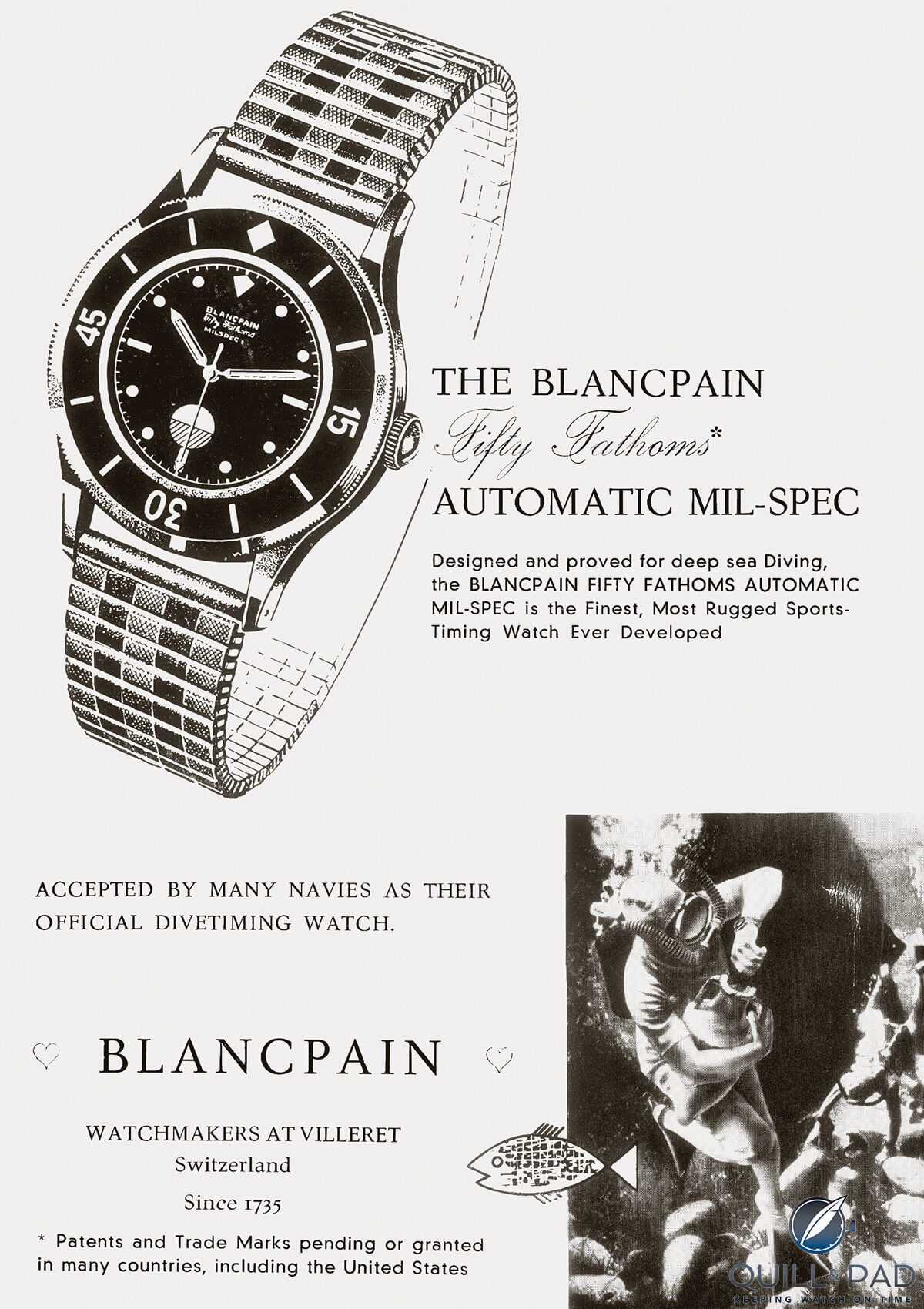
Advertisement for the original Blancpain Fifty Fathoms MIL-SPEC
And now, more than 50 years later, Blancpain has chosen to commemorate the early years of the extremely capable Fifty Fathoms by releasing a tribute to a specific model named the MIL-SPEC 1 that was released in 1957-58 and designed for military applications.
The new model is therefore aptly named the Tribute to Fifty Fathoms MIL-SPEC and reintroduces a feature that makes it one cool technical timepiece.
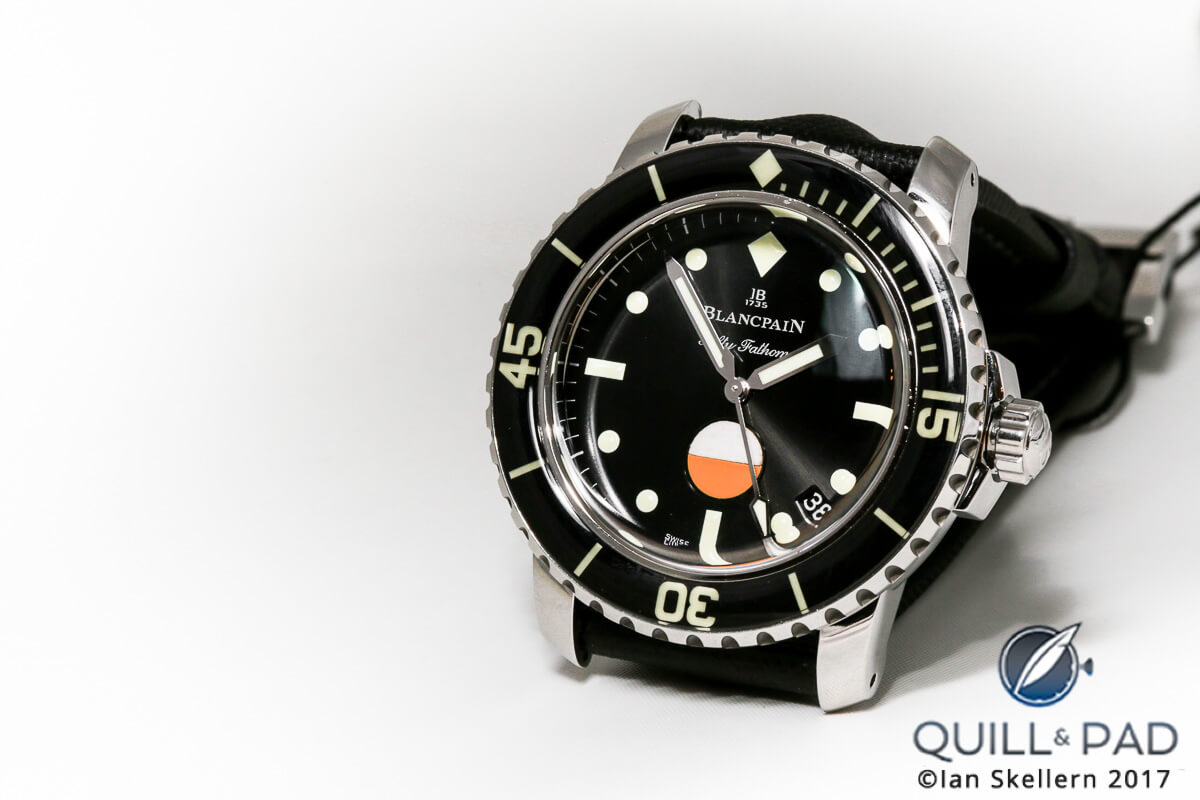
Blancpain Tribute To Fifty Fathoms MIL-SPEC
The basics of the Tribute to Fifty Fathoms MIL-SPEC are centered on many visual characteristics found in the original MIL-SPEC 1 and the modern upgrades that come with advancement in technologies.
First up is the size, which by today’s standards is small and reasonable but by standards of the time of the original MIL-SPEC 1 is “very large.” This means that the diameter is just a smidge over 40 millimeters (40.3 to be exact), the current “Goldilocks” diameter so many WIS desire.
This is a full five millimeters smaller than pretty much the entire Fifty Fathoms collection (not including the Bathyscaphe chronograph) and already has fans clamoring for this diameter to be made in a non-limited edition for the regular collection.

Blancpain Tribute To Fifty Fathoms MIL-SPEC
The dial and bezel very closely resemble those produced in the late 1950s, with the main divergence being a date window at 4:30 and an updated logo. The hour and minute markers, the hands, and the bezel markings all feel incredibly loyal to the watch’s inspiration and strangely enough seem perfectly current as well.
But the biggest and best feature on the dial is the reintroduction of the water-resistance indicator.
Water-resistance indicator: old plus new technology
The water-resistance indicator placed squarely at 6 o’clock could also be called a leak indicator as this is what the color-changing spot really displays. The indicator is a circle split into two halves, the lower of which is a painted a yellowish orange reference color, while the upper half comprises water-sensitive paper that turns from white to red when exposed to high humidity or liquid.
The process of the color change is irreversible, meaning that the color remains so that the owner knows if any water leaked into the case once he or she has resurfaced. This is important since most colors aren’t recognizable underwater, and reds are the first to go.
If the case is compromised and the indicator is red, then you know you can’t trust the watch to keep accurate time and it will need to be serviced. Since the color change is irreversible, at the service the paper (along with the dial due to its construction technique) will be replaced with a fresh indicator for continued use after service.
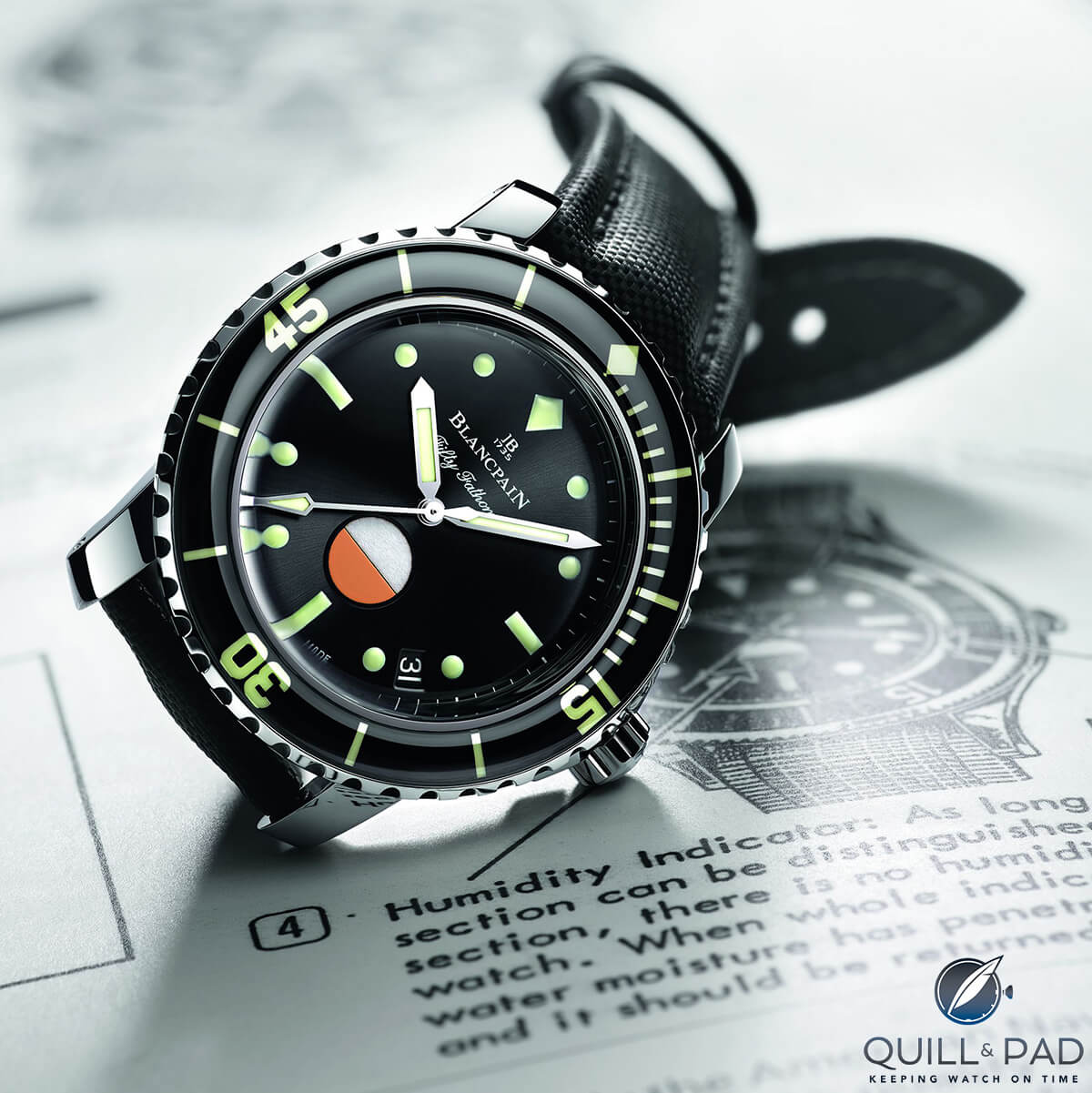
Blancpain Tribute To Fifty Fathoms MIL-SPEC
The indicator color change needs to be irreversible so that a permanent record of leakage remains in case it went unnoticed (like on the last dive of the day) and the paper dried out, changing the color back to normal.
The technology behind indicator strips is actually fairly commonplace, having been employed for military use since the middle of the twentieth century. The color change is achieved by a moisture-sensitive chemical impregnated into the paper substrate. The chemicals (depending on specific formula) attract water molecules that fuse, changing the structure of the base chemical (usually cobalt or copper chloride). This shift effectively changes the wavelength of light the chemical reflects, modifying the visible color.
Who would have thought a watch brand would combine chemistry and physics to keep a watch safe?
Following the initial design requirements of the original, the Tribute to Fifty Fathoms MIL-SPEC is powered by automatic Caliber 1151, which keeps any wear on the winding stem and O-ring gaskets at a minimum. The solid gold rotor is a better than the original, the gold’s higher mass increasing winding efficiency to twin spring barrels offering a very healthy four days of power reserve.
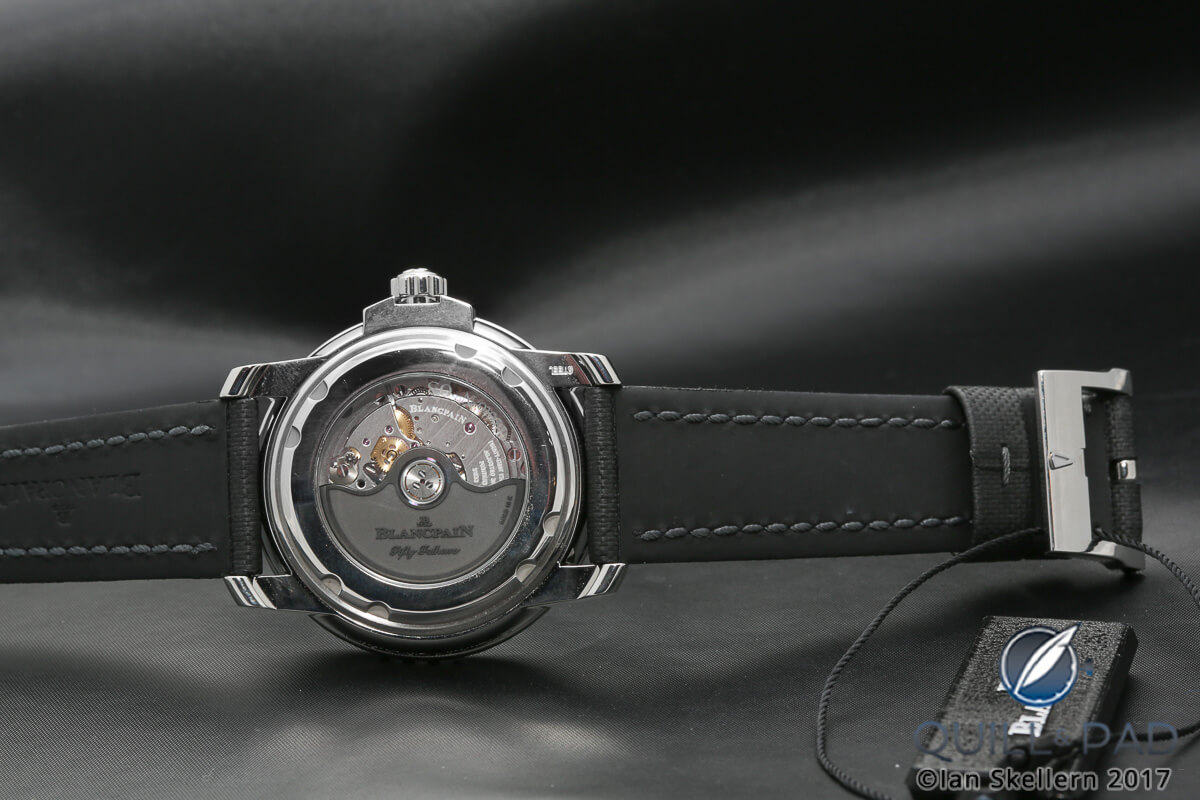
Back of the Blancpain Tribute To Fifty Fathoms MIL-SPEC
Another feature of Caliber 1151, one that has been divisive in haute horlogerie circles, is the silicon balance spring. Of course it isn’t an original feature (hadn’t been invented yet), but it has been proven to be clearly superior to formed alloy balance springs.
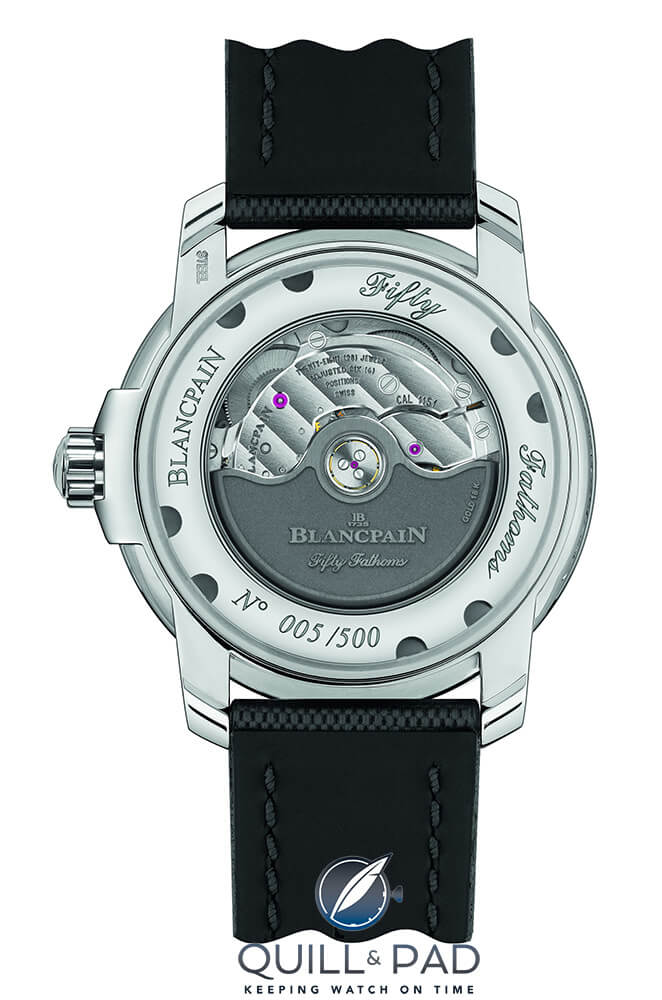
Back of the Blancpain Tribute To Fifty Fathoms MIL-SPEC
Improved isochronism and completely non-magnetic (important for diving watches), the silicon balance spring really is the only logical choice for a modern performance timepiece, especially one that you depend on for your life.
Greatness that should be built upon
When you combine the old and the new in the ways that Blancpain has done with the Tribute to Fifty Fathoms MIL-SPEC, the result is one heck of a watch. While it must be stated that this timepiece isn’t itself a MIL-SPEC watch, the inspiration, resulting design, and functionality are still rather cool as a tribute.
Two elements that perhaps seem out of place – a large, engraved “Blancpain” on the side of the case and a transparent case back – don’t kill the watch, but simply illustrate that it is something new that references something old. It also shows that Blancpain won’t be a slave to reissues for the sake of rehashing old designs, but instead honors successful designs with new technology.
This is the best of both worlds when it comes to watchmaking, a method of design used by many that understand the value of functionality over sentimentality.
The Fifty Fathoms has always been an awesome watch, and the designs literally have become iconic, defining a genre of watches for more than 60 years, so I am happy to see a return to the original combined with the best of what’s new.
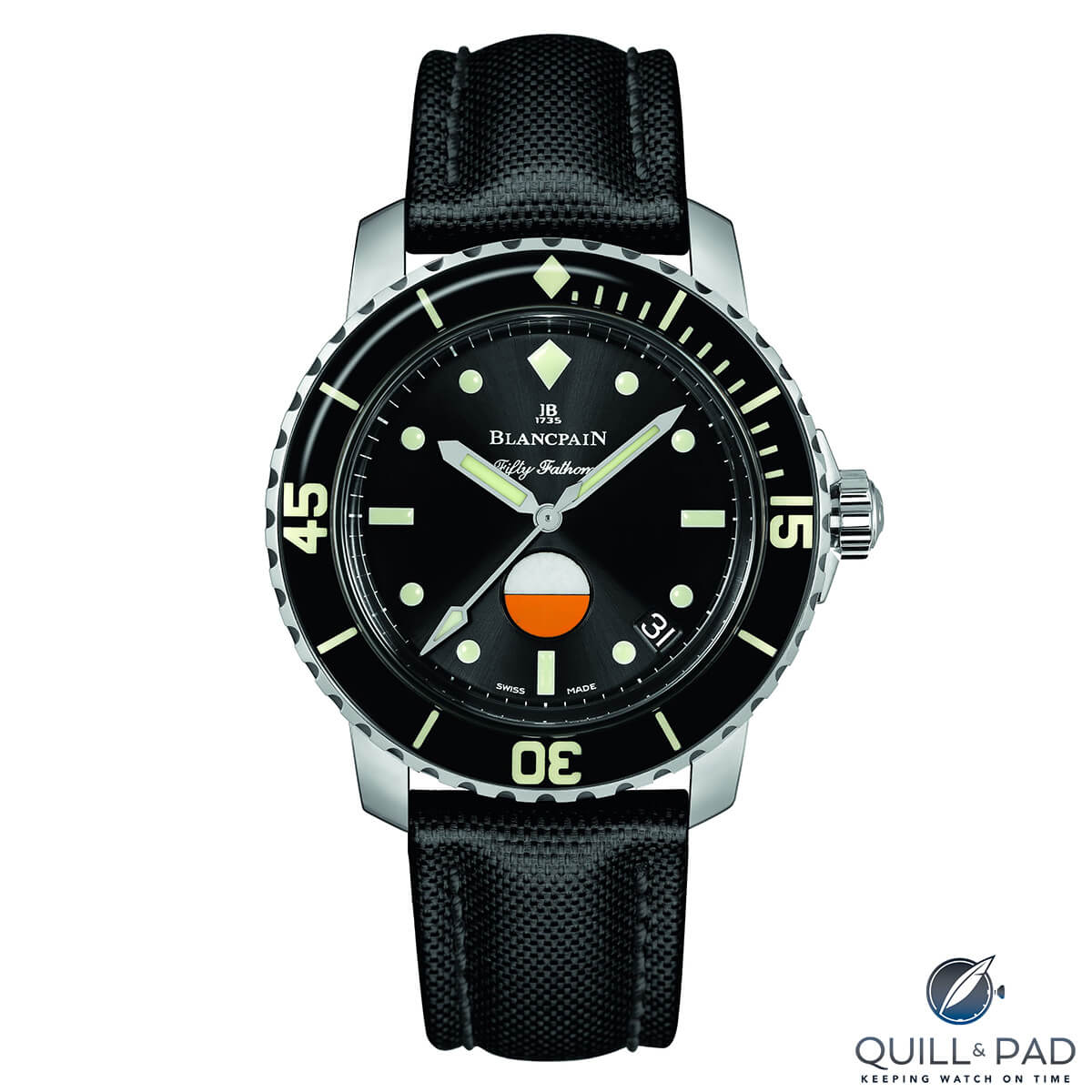
Blancpain Tribute To Fifty Fathoms MIL-SPEC
Perhaps the excitement over this piece will show Blancpain that there is still a market for smaller, yet bold, diving watches and that the company is on the right track.
While we wait to see what comes next, how about the breakdown!
- Wowza Factor * 9.27 This is definitely a wowza of a watch if you care about the history of the Fifty Fathoms or diving in general.
- Late Night Lust Appeal * 88.8 » 870.830m/s2 Strong pressure coming from the weight of all the water you can dive under with this piece. It makes me want to take up diving for treasure!
- M.G.R. * 55.9 Very well made movement, silicon balance spring, four-day power reserve, what more can you ask for from a movement placed in a diving watch!
- Added-Functionitis * Moderate The added date makes this watch more functional (unless you are a purist, then it’s utter nonsense), but the color-changing water-resistance indicator takes the watch to another level for practical functionality. You will definitely need full strength Gotta-HAVE-That cream for the underwater swelling!
- Ouch Outline * 11.4 Dropping a sheet of plywood on your foot! Of course this shouldn’t happen often, but sometimes it sneaks up on you. Still, I would gladly let it happen if it meant this watch was on my wrist while I swam in a river of my own tears.
- Mermaid Moment * First Sight (Or Not)! There are many who prefer other watches and that is fair. It may be wrong, but it is fair. Still, I knew when I saw it that I should start getting fitted for a tuxedo!
- Awesome Total * 709 Multiply the diameter of the case (40.3) with the water resistance in bar (30) and then subtract the number of pieces in the limited edition (500) for a rather wet awesome total!
For more information, please visit www.blancpain.com/en/news/tribute-fifty-fathoms-mil-spec.
Quick Facts Blancpain Tribute to Fifty Fathoms MIL-SPEC
Case: 40.3 x 13.23 mm, stainless steel
Movement: automatic in-house Caliber 1151 with silicon balance spring
Functions: hours, minutes, seconds; date, water-resistance indicator
Limitation: 500 pieces
Price: $14,100 / €13,070



Leave a Reply
Want to join the discussion?Feel free to contribute!